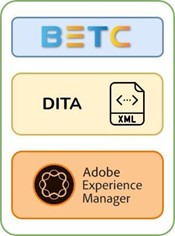How BODEX organized and managed useful content by using DITA based Knowledge Bases
Problem Statement
In companies working on a large scale, managing articles, and keeping them updated is a tedious task. One of our Clients from a Semiconductor manufacturing company was also facing a similar kind of problem. They came to us and explained their following pain points:
- No standards for content and constant rework required
- Can’t keep up with brand updates and format changes
- Valuable information is getting lost due to lots of unused and confusing articles.
- No means to make the Knowledge Bases Multilingual

Solution
We at BODEX, are not only experienced in creating DITA based knowledge bases but can also make them multilingual with ease.
So, we helped them in managing their documents and articles by creating DITA based Knowledge Bases.

A knowledge base can encompass many forms of content, including:
- Frequently asked questions
- Step-by-step process guides
- Introductory articles
- Video demonstrations
- Glossaries and definition lists
What is DITA:
Darwin Information Typing Architecture (DITA) is an XML data model for authoring and publishing.
Other content systems use typical systems to store content in a Tangled way, where all the content is tangled in a single document. Whereas the DITA system uses components like Topics and Maps to create a document.
- Topic: –
A Topic is a chunk of content which only addresses a single subject or answers a single question.
By using this Topics, it becomes very easy to create, reuse and rearrange the content in a document.
There are usually 3 types of Topics: Concept, Task and Reference.
- Maps: –
In a DITA document there are multiple Topics, but these topics do not have a meaning if they aren’t organized in an order. So that’s the job of a DITA map.
A DITA map provides order and hierarchy, navigation (like a table of contents) and cross topic links.




Outcome
- Flexibility & Reuse – DITA provides a flexible, yet rigid, framework that helps you reuse, reorganize, and create content quickly.
- Time & Money Savings – DITA increases productivity and enables better collaboration for faster delivery, and you can distribute work so writers can work in parallel thanks to topic-driven architecture.
- Process Automation – DITA offers various ways to automate processes such as index or glossary production, output, delivery, validation and more.
- Easy to Manage – Whenever we want to edit or update some part of a content, we can just go to the topic and edit it. No need to edit the whole document.
- Multilingual Feature – The best part of using DITA for a Knowledge Base is that we can easily make it multilingual. The DITA topics can be easily translated using AEM connectors and then those topics can be used to create DITA maps. The whole process will be primarily automated.
Download
Other Case Studies

Have a similar problem?
If you have a similar problem on which we can help you, give BODEX a chance to solve it. We will apply our proprietary methodology to make sure your business works to your specifications and satisfaction.
